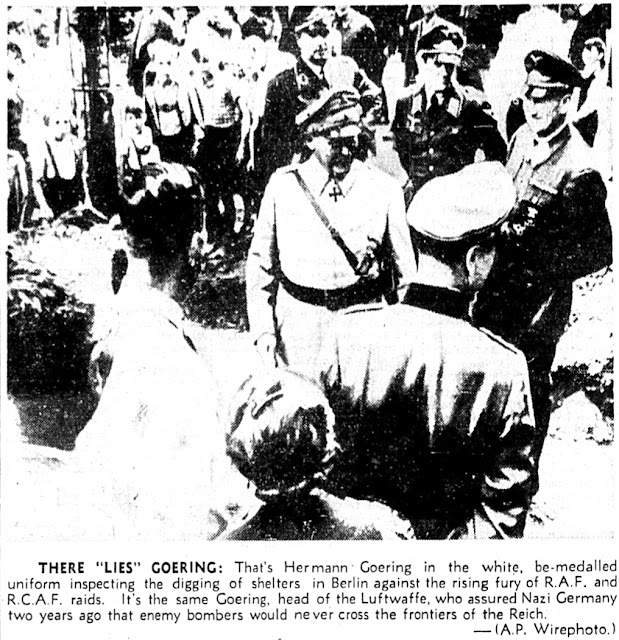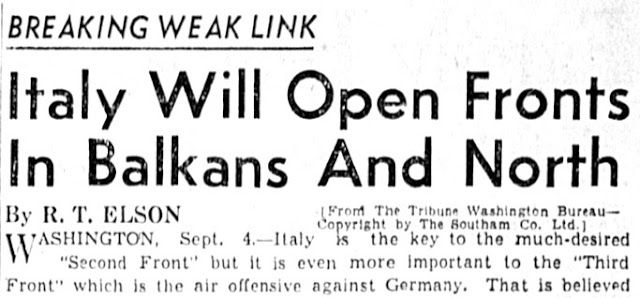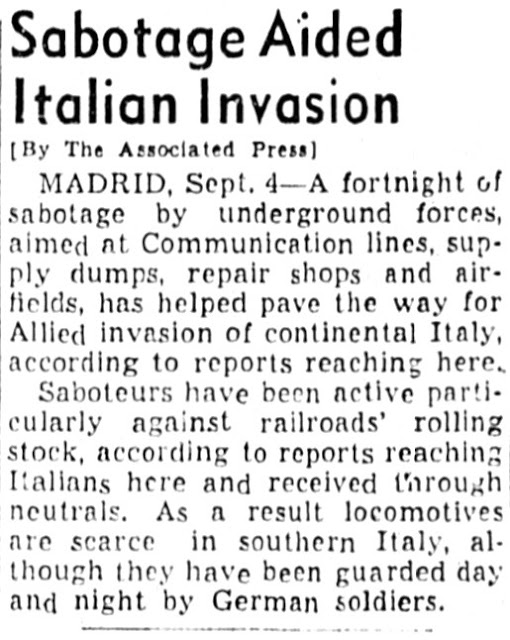The Invasion of the Toe of Italy's Boot, Beginning Sept. 3, 1943
Articles, Context from The Winnipeg Tribune, Sept. 4, '43
Are people of Sicily looking across the Messina Strait to the toe of the boot?
Photo Credit - The Winnipeg Tribune, Sept. 4, 1943, page 6
Introduction:
Operation Baytown began in the early morning of September 3, 1943. A heavy barrage was followed by invasion forces (Monty's Eight Army and the Canadian First Division) that crossed the Messina Strait (nervously at first, later rather peacefully) on landing crafts of all sizes, destined to disembark upon a ten-mile-wide, unopposed beachhead with Reggio di Calabria at its centre.
Significantly, Canadians troops were carried for the first time aboard Canadian landing crafts, i.e., the 80th Flotilla of LCMs. Many details re the crossings have already been shared in Part 4a and Part 4b of this series. Most details are from The Winnipeg Tribune (digitized), including stories by Canadian war correspondents, and several items are from rare sources, books containing stories written by veterans of WWII who were there at the time.
More details follow on D-Day +1, i.e., one day after disembarkation day, primarily from the same resources at our disposal, i.e., The Tribune and navy memoirs:
Read about the three Italian cities that were captured quickly below, and why the "sweep" was unexpectedly easy:
While the British and Canadian armies are making significant advances upon Italy's toe, as well as inland, reinforcements from Canada are landing on UK shores:
Those who are pressing for another Allied landing - this time "a full-scale invasion of Europe across the English Channel (e.g., northern France)" - will have to wait until June, 1944, nine months in the future:
Goering was wrong once, and he'll likely be wrong again
Before we read Ross Munro's article from Sept. 4 (designated as "Delayed" from Sept. 3, D-Day Italy), I share this brief piece from the previous day - dispatched to Canada from London - that indicates where Munro was on the 3rd. Please note the second sentence that begins, "If this indication is borne out..."
Well, Munro's own article does indicate that the indication was in fact borne out! Now we actually know that he was in fact where somebody else said he was on the day of the invasion. Fourth times a charm?
Yes, I could have just let Mr. Munro speak for himself...
The blotched out word below refers to "the beaches of Pachino"...
Some readers can now likely guess why Munro's news re September 3rd, the day of invasion, was delayed. Yes, he likely spent a lot of time talking to "hundreds of troops", but then he'd have to sit down and do some typing. And when finished typing... he'd have to get his finished pages back to a location (perhaps by landing craft) where they could be transmitted in some way back to his HQ (censors would have to take a peek) and then to Canada (likely by underwater cable). It's complicated, and Mr. Munro wrote a column about the laborious process... and when I find it I will include it here : )
Sholto Watt, another fine, Canadian war correspondent (with The Montreal Star) adds his perspective, also designated as "Delayed".
A few descriptive passages from other news articles by Mr. Watt,
including his view of Reggio on Sept. 2, 1943, can be found here.
The answer to the question below is... Salerno, September 9:
Perhaps unbeknownst to the illustrator of the following editorial cartoon - also seen at top of page - his image would remind people who stood on Sicily's shore (Allied troops, Sicilian residents) and looked across to Reggio di Calabria (on the toe of the boot), that a victory bell had been rung.
And readers who are familiar with Sholto Watt's Montreal Star column from September 2nd, would perhaps sense a connection between his final words and the "First Light of Dawn."
Watt's final words:
And the next morning
in the hours of darkness,
I stood above the Straits and heard
and saw the shattering bombardment
which breached the first wall of the dungeons
and came to the ears of jailers and victims
throughout the prison of Europe.
The scene above actually looks a lot like what one would see when looking from Sicily's shore to the Italian mainland. Dorman H. Smith, the illustrator, was either lucky or had done his homework... or....?
Randolph Patton, also featured in the previous post, has more to say on the editorial page of The Trib:
Patton writes about Montgomery's progress "along 140 miles of coast... along the sole of the Italian boot," and suggests that if "the Germans are not present in strength" then "progress inland should be rapid."
There is evidence that some of the Canadians in Combined Operations, i.e., members of the 80th Flotilla, manned landing crafts that assisted in other long ventures along the coast.
In St. Nazaire to Singapore: The Canadian Amphibious War 1941 - 1945, Volume 1, we can read a short account by Ed Corbett (RCNVR, Combined Operations, 80th LCM Mark 3 Flotilla) about the landing in Italy and plans to move many miles "up (the) coast of Italy."
He recorded the following in his diary:
St. Nazaire to Singapore..., page 191
Corbett provides many details in a short breath, and I will elaborate on a few:
Sept. 1. "Moving out today" - from Augusta, Sicily.
Sept. 1. "We are landing in Italy and are to take (troops, materials of war) to Reggio Calabria. 926 guns, also naval guns (were on hand to bombard the Italian coast at Reggio).
Sept. 2. "Landed at St. Teresa, Italy" - Santa Teresa di Riva, Sicily (about 10 miles south of Messina).
Sept. 2. "Zero hour (for landing or disembarking Canadian troops) 0430" - 0430 coincides with the time given in a newspaper report entitled "Beachheads Established" in previous post, Part 4b.
Sept. 3. "We are making 42 mile round trip." - Though my father and Ed Corbett were members of the same flotilla, and there is some chance they travelled together at times, my father recalls a seven-mile trip from Messina to Reggio, or 14-mile round trip.
Sept. 4. "Was ashore in Italy." - the photos and captions below are attributed to Ed Corbett:
"First lunch on mainland Italy. Men of the 80th LCM Flotilla" Photo - Ed Corbett,
found in St. Nazaire to Singapore: Canadian Amphibious War, Vol. 1, pg 192
Photo - Ed Corbett, found in St. Nazaire to Singapore: Vol. 1, pg 192
Sept. 5. "...loaded troops for assault on town 150 miles up (the) coast of Italy" - based on Corbett's future mention of Salerno, the troop movement is likely related to the American and British combined operation on Italy's shin, not the sole of the boot as Patton described.
[Editor's Note - Ed Corbett and other Canadian members of RCNVR and Combined Operations were certainly used to long amphibious voyages. By landing craft they had travelled from Sicily to Malta after their work during Operation Husky was completed (i.e., related to the invasion of Sicily, beginning July 10, 1943); they had journeyed back to Sicily as well in preparation for the invasion of Italy, Operation Baytown, beginning September 3.
And in order to get to the Mediterranean Theatre of War in the first place, they had travelled 1,000s of miles aboard troop and cargo ships around the continent of Africa in order to enter the Mediterranean via the Red Sea and the Suez Canal.
Below is a Navy hammock with names of some of the members of the 80th Flotilla of Landing Crafts at work in Italy in September. Ed Corbett's name is seen in the left column and almost opposite is D. Harrison, my father. The hammock can be seen, by appointment, at the Navy Museum in Victoria, B.C.]
Photo Credit - The Navy Museum, HMCS Naden, Victoria, BC
"My first reaction after unrolling the hammock was to hold it to my nose. It
smelled like diesel fuel, perhaps because it belonged to W. Katana, stoker."
Photo - G. Harrison, Editor. B.C. 2014
Sept. 5 - 6. "Cancelled... bad weather. Sailed for Messina." - sounds like Ed's services changed - for only a few days - from moving troops many miles northward to ferrying supplies to Italy's toe, closer at hand.
More details from Corbett's diary will be revealed in future posts.
And now, back to The Winnipeg Tribune;
And now, back to The Winnipeg Tribune;
The next post will share an article about how the Allies were putting a few hundred miles of Sicily's railroads to good use!
Meanwhile, on another war front, Mme. Chiang Kai-Shek inspects ruins in China's provisional capital;
And last but not least (also delayed!), Chips - the Wonder Dog - wins a major award.
More news to soon follow from the Monday paper, September 6, 1943.
Please link to Editor's Research: Operation Baytown (Italy WWII) (4b)
Unattributed Photos GH






























No comments:
Post a Comment